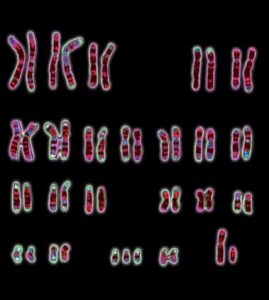Brian’s Health: Down Syndrome
Down Syndrome Overview
- There are 23 pairs of chromosomes, for a total of 46.
- Half the chromosomes come from the egg, and the other half from the sperm.
- This XY chromosome pair includes the X chromosome from the egg and the Y chromosome from the sperm.
- In Down’s syndrome, there is an additional copy of chromosome 21, resulting in three copies instead of the normal two copies.
- Trisomy 21 (also known by the karyotype 47,XX,+21 for females, 47,XY,+21 for males) is caused by a failure of the 21st chromosome to separate during egg and sperm development (nondisjunction).
Three Genetic Variations
Trisomy 21
About 95 percent of the time, Down syndrome is caused by trisomy 21 — the person has three copies of chromosome 21, instead of the usual two copies, in all cells. This is caused by abnormal cell division during the development of the sperm cell or the egg cell.
Mosaic Down syndrome
In this rare form of Down syndrome, a person has only some cells with an extra copy of chromosome 21. This mosaic of normal and abnormal cells is caused by abnormal cell division after fertilization.
Translocation Down syndrome
Down syndrome can also occur when a portion of chromosome 21 becomes attached (translocated) onto another chromosome, before or at conception. These children have the usual two copies of chromosome 21, but they also have additional genetic material from chromosome 21 attached to another chromosome.
Risk Factor
- Advancing maternal age. A woman’s chances of giving birth to a child with Down syndrome increase with age because older eggs have a greater risk of improper chromosome division. A woman’s risk of conceiving a child with Down syndrome increases after 35 years of age. However, most children with Down syndrome are born to women under age 35 because younger women have far more babies.
- Being carriers of the genetic translocation for Down syndrome. Both men and women can pass the genetic translocation for Down syndrome on to their children.
- Having had one child with Down syndrome. Parents who have one child with Down syndrome and parents who have a translocation themselves are at an increased risk of having another child with Down syndrome. A genetic counselor can help parents assess the risk of having a second child with Down syndrome.
Screening During Pregnancy
-
First trimester combined two step test:
-
- Blood test-measures levels of pregnancy-associated plasma protein-A (PAPP-A) and human chorionic gonadotropin (HCG). Abnormal levels of both may indicate a problem with the baby.
-
- Nuchal translucency test-an ultrasound is used to measure a specific area on the back of the fetus’s neck. When abnormalities are present, more fluid tends to collect in this neck tissue.
-
Second trimester:
-
- Blood test-measures four pregnancy-associated substances: alpha fetoprotein, estriol, HCG, and inhibin A.
-
- If screening test results are positive or you are at high risk, more testing to confirm the diagnosis may be done.
-
- Chorionic villus sampling (CVS)-cells are taken from the placenta and analyzed. Usually done in the 1st trimester. The risk of miscarriage is very low.
- Amniocentesis-sample of amniotic fluid is withdrawn using a needle inserted into the uterus to analyze the fetus chromosomes. Done in 2nd trimester, risk of miscarriage is very low.

